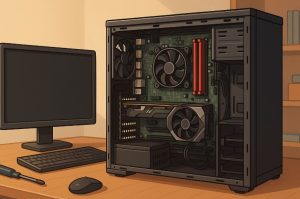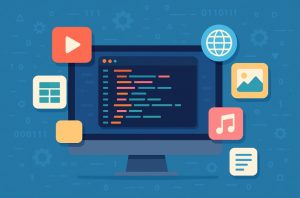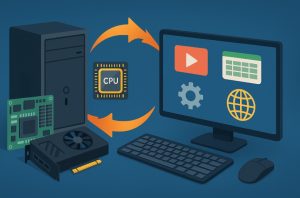
In the ever-evolving world of technology, understanding the basics is often overlooked, yet essential. One such fundamental concept is the difference between hardware and software of computer systems. Computers play a pivotal role in nearly every aspect of daily life education, communication, healthcare, and business operations.
Despite their ubiquity, many users do not fully grasp how the two core elements of a computer system as hardware and software, they differ yet rely on each other for seamless performance.
This article explores the nature, types, interdependencies, and real-world relevance of both hardware and software, providing a complete perspective for general users and beginners alike.
What Is Computer Hardware?

Computer hardware refers to the physical components of a computer system. These are the tangible parts you can touch, see, and physically handle. Whether it’s the sleek monitor on your desk or the central processing unit hidden within the case, each part has a distinct function.
These components collaborate to perform tasks, process data, and deliver output. The effectiveness and speed of a computer often rely on the quality and configuration of its hardware.
What are the Common Internal Hardware Components?
- Central Processing Unit (CPU): Often called the brain of the computer, it handles all instructions from software and performs calculations.
- Motherboard: The main circuit board that connects all internal components and allows communication between them.
- RAM (Random Access Memory): Provides temporary storage that the CPU uses to store data that’s being processed.
- Storage Drives: Includes hard disk drives (HDDs) and solid-state drives (SSDs) which store the operating system, software, and personal files.
- Graphics Processing Unit (GPU): Manages and enhances visual output.
What are the External Hardware Components?
- Monitor: Displays visual output from the computer.
- Keyboard and Mouse: Used to input commands and navigate interfaces.
- Printer and Speakers: Output devices that deliver results in print or sound.
What are the Types of Computer Hardware and Their Functions?
Computer hardware can be broadly classified into four categories. Here’s a detailed table showcasing their types and purposes:
| Type | Description | Examples |
| Input Devices | Allow users to enter data and commands into the system | Keyboard, Mouse, Microphone, Scanner |
| Output Devices | Convert digital signals into human-readable forms like text or sound | Monitor, Printer, Speakers |
| Storage Devices | Store data temporarily or permanently | HDD, SSD, USB Drive, CD/DVD |
| Internal Components | Perform data processing and enable system functionality | CPU, RAM, Motherboard, GPU |
These components together make it possible for a user to execute tasks, whether it’s browsing the internet or running complex simulations.
What Is Computer Software?

Unlike hardware, software is the collection of digital instructions that tells the computer what to do. It is intangible, meaning you cannot touch or see it in physical form. Yet, without it, even the most advanced hardware remains idle.
Software is typically written in programming languages and compiled into machine-readable code that can be executed by the CPU. It bridges the user’s commands and the hardware’s actions.
Software can range from simple tools like a calculator app to complex operating systems or enterprise-level management programs.
What are the Types of Computer Software and Their Roles?
Software is broadly divided into two main types, each serving specific purposes within a computing environment:
| Software Type | Description | Examples |
| System Software | Operates directly with hardware and manages system resources | Operating Systems (Windows, macOS), Device Drivers, Utilities |
| Application Software | Designed for end users to carry out specific tasks | MS Word, Excel, Photoshop, Chrome, Video Players |
System software acts as a foundation, without which application software cannot function. Application software, in contrast, focuses on usability and user-specific needs.
Additionally, firmware is another category often discussed alongside system software. Firmware is a type of software permanently programmed into a hardware device to control its functions.
How Hardware and Software Work Together?

Hardware and software are interdependent. Software provides the instructions that hardware executes, and hardware is the platform that software runs on.
Let’s consider a real-world example:
You open a document in Microsoft Word and click ‘Print.’ The software (Word) sends instructions to the operating system, which communicates with the printer’s driver (another form of software). The printer (hardware) then prints your document.
This relationship forms a continuous cycle:
- User interacts with software
- Software interprets commands
- Software sends signals to hardware
- Hardware executes the instructions
- Output is generated and delivered to the user
Without software development, a computer’s hardware components cannot communicate or function in unison. Without hardware, software has no medium to operate within.
How Can We Differentiate Hardware and Software?
To better understand the distinction and interrelation, here’s a detailed comparison table:
| Attribute | Hardware | Software |
| Nature | Physical components | Digital instructions |
| Tangibility | Tangible (can be touched and seen) | Intangible (can only be interacted with virtually) |
| Creation | Built using electronic and mechanical materials | Developed using programming languages |
| Role | Executes tasks as directed by software | Provides instructions and user interfaces |
| Upgradability | Requires physical replacement or enhancement | Can be upgraded through patches or new versions |
| Durability | Prone to physical damage and wear | Does not degrade physically but can become outdated |
| Virus Susceptibility | Immune to software viruses | Vulnerable to malware, ransomware, and viruses |
| Transferability | Cannot be transferred over a network | Can be downloaded, shared, or installed remotely |
| Dependency | Needs software to operate | Needs hardware to run |
| Examples | Monitor, CPU, RAM, Printer | MS Word, Operating Systems, Antivirus |
How Can You Understand Hardware and Software Through a Real-Life Analogy?

To better grasp the difference between hardware and software, consider a simple yet powerful real-life analogy: a theatre production.
In this analogy:
- Hardware represents the physical stage, the props, the lighting systems, and the sound equipment. These are all tangible items that you can see and touch. They provide the environment in which the performance takes place.
- Software, on the other hand, is the script, the direction, and the choreography, the set of instructions that tell the actors (and crew) what to do. It also includes the actors themselves, as they follow the script to bring the performance to life.
Without the stage and equipment (hardware), the actors have nowhere to perform. Without the script and direction (software), the performance lacks purpose and structure.
Similarly, in a computer:
- Hardware includes your screen, keyboard, CPU, and motherboard, these are your props and stage.
- Software consists of the operating system and applications, these are the instructions and performances happening on that stage.
If a lightbulb on the stage breaks (hardware failure), it must be replaced. If the script has a plot hole (software bug), it must be revised. Both elements are essential, and both must work in perfect harmony to deliver a successful show or in this case, a smooth computing experience.
We can also compare this relationship to the human body and mind:
- The body (hardware) includes organs, muscles, and limbs tools that perform actions.
- The mind (software) gives commands and interprets stimuli, directing the body to act.
In either analogy, it’s clear: the hardware provides the structure, while the software provides the purpose. They are interdependent, and one without the other cannot function effectively.
This simple analogy helps demystify what might otherwise feel like a technical or abstract distinction, making it easier for everyday users to appreciate the core functionality of their devices.
Why It’s Important to Understand the Difference?
Understanding the distinction between hardware and software is not just for IT professionals. Everyday users benefit from this knowledge by being able to:
- Troubleshoot basic problems
- Make informed decisions when purchasing new devices or software
- Identify performance bottlenecks
- Upgrade their systems efficiently
Moreover, businesses increasingly depend on both high-performing hardware and tailored software solutions to streamline operations, improve customer engagement, and ensure data security.
Conclusion: Two Halves of One Whole
To sum up, the difference between hardware and software of a computer lies in their structure and function. Hardware forms the foundation, the physical entity while software gives it life and direction. They are distinct yet inseparable in the context of modern computing.
As technology continues to evolve, the synergy between hardware and software remains at the core of innovation. Whether you are buying a new laptop, installing an app, or learning IT skills, appreciating this foundational difference helps you navigate the digital world with greater confidence.
What are the Frequently Asked Questions About Hardware and Software?
What happens if a computer has hardware but no software?
Without software, hardware has no instructions to follow and cannot perform any function. It remains an inactive assembly of components.
Can software run independently of hardware?
No. Software needs hardware to be executed. It is designed to operate on a physical system like a PC or server.
Is an operating system hardware or software?
An operating system is a type of system software that manages hardware and provides a platform for running application software.
Are peripherals like a mouse and monitor considered hardware?
Yes, these are hardware devices more specifically, input and output peripherals.
What is firmware, and how does it differ from software?
Firmware is a permanent type of software embedded into hardware components to control their basic functions. It is different from regular software, which can be installed or updated more frequently.
What causes software failure compared to hardware failure?
Software failures often result from bugs, overload, or compatibility issues. Hardware failures usually stem from physical wear, power surges, or environmental damage.
Which is more expensive to replace: hardware or software?
Generally, hardware tends to be costlier to replace due to its physical nature. However, specialised software with licensing fees can also be expensive depending on the application.